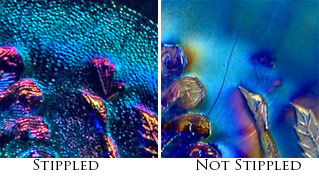by Dr. Larry Keig for the ICGA Pump Newsletter
Stippled Rambler Rose is nicely designed, attractive, and interesting, but rarely seen. No doubt named for its open flowers’ resemblance to Dugan’s Rambler Rose, the pattern-defining element looks like the wild rose found in protected areas and along roadsides of rural America.
Nothing is known of the provenance of the pattern. There has been speculation that it was made by Dugan or Diamond, but there is no documentary evidence to support either attribution. Others have suggested that it may be of English or continental European origin.
Each of three panels is composed of a dominant highly embossed rose and leafage which flanks the flower—two slender leaves to the left, three to the right. Beneath the botanical elements are two raised swirls, each originating from a tiny bullet. The swirl on the right flows counterclockwise outward to become part of an elaborately filigreed, bold border which separates the panels. The swirl on the left extends clockwise outward to achieve the same effect. The patterned areas are set against a stippled background. The stippling clearly meets Dr.Glass’s (HOC Mailing List, Episode 82, September 11, 2019) criterion that in order to be classified as “stippled,” nearly all the non-patterned area of a piece be covered with this sandy surface,
The only shape on which the pattern has been confirmed is a nut bowl. It is four inches tall and six inches across the top. The top is scalloped in an unconventional way. The 16 alternate between the typical rounded variety and an unusual, perhaps unique “scalloped scallop” in which the scallop is segmented into three mini-scallops. The bowl sits on three elongated stubby feet. These measure about an inch across and a half-inch deep. The nut bowls have been confirmed only in marigold, although cobalt blue is said to exist. It seems surprising that no Stippled Rambler Rose rose bowls have been reported.
Stippled Rambler Rose and Dugan and Diamonds Grape Delight nut bowls are similar in shape. Both are about the same in height and top diameter and identical in number of scallops around the top, even as the Grape Delight are conventionally scalloped. But while both sit atop stubby feet, Grape Delight’s six are much narrower across than those of the Stippled Rambler Rose.
Greg Dilian found the illustrated example at the Brimfield, Massachusetts, flea market in July 2019. After posting photos at the Thistlewood carnival website. he received considerable comment, with even veteran collectors expressing unfamiliarity with the pattern. But none of the respondents were able to help identify when or by what company it was made.
If, and that’s a big “if,” Stippled Rambler Rose was produced in western Pennsylvania, it seems more likely it’s Dugan rather than Diamond. Dugan’s patterns are generally more intricate than Diamond’s, and Stippled Rambler Rose is more elaborate than most of the patterns designed and put into production after the Dugan Glass Company was bought out by Diamond. Yet marigold, the sole color in which Stippled Rambler Rose has been verified, was by far the commonest of Diamond colors, not-so-often seen during the Dugan years. So, who knows?
Stippled Rambler Rose nut bowls may have been made at about the same time Grape Delight rose and nut bowls appeared in wholesale catalogs for the first time in 1912. Or they may have appeared just before the firm was restructured with production continuing for a short time just after the ownership change. Should that be the case, Stippled Rambler Rose would have been manufactured two or three years before Rambler Rose was introduced. That would have given the firm time to significantly redesign the pattern and apply it to its new marketing emphasis on pitchers and tumblers.
But maybe not. Perhaps, given the differences in the two patterns, Stippled Rambler Rose was produced abroad or by another yet unidentified domestic glassmaker.

